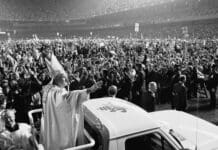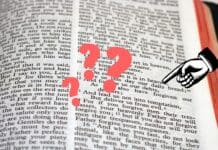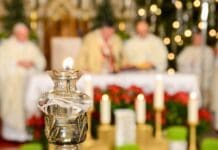During Mass you may notice the priest will at times assume the orans posture, hands raised and outstretched with elbows at his sides, especially during the prayer of the Our Father. Many members of the Faithful may join the celebrant in such a gesture. Would it surprise you to learn that doing so is contrary to Church teaching?
Orans, a loanword from the Medieval Latin ōrāns meaning one who is praying or pleading, is a posture of prayer where one standing has their hands outstretched sideways palms up, with their elbows close to the body. The Orans is seen an ancient Christian symbol of a soul in union with God interceding on behalf of mankind, frequently depicted in Early Christian art in a gesture reminiscent of Christ’s outstretched arms as He offered Himself on the Cross.
For centuries, the Pater Noster has been a pivotal part of Mass, taking place during the Liturgy of the Eucharist. However, because of language barriers and development of rubrics, the Our Father was traditionally a prayer said by the celebrant on behalf of the congregation, not with them. Any prayer offered up to God by the priest is done assuming the orans position.
Liturgical reforms promulgated by Pope Pius XII on September 3, 1958 granted permission for the lay faithful to join the priest in praying the Our Father. However, no prescriptions were made for said lay faithful to join the priest in the orans position, instead remaining standing with hands folded in prayer.
“Since the Pater Noster is a fitting, and ancient prayer of preparation for Communion, the entire congregation may recite this prayer in unison with the priest in low Masses; the Amen at the end is to be said by all.” – Instruction on Sacred Music and Sacred Liturgy § 32
In 1997, Pope Saint John Paul II delivered instructions “On Certain Questions Regarding the Collaboration of the Non-Ordained Faithful in the Sacred Ministry of Priest: Practical Provisions”, a document which you can read here. The late pontiff said:
“In eucharistic celebrations deacons and non-ordained members of the faithful may not pronounce prayers — e.g. especially the eucharistic prayer, with its concluding doxology — or any other parts of the liturgy reserved to the celebrant priest. Neither may deacons or non-ordained members of the faithful use gestures or actions which are proper to the same priest celebrant. It is a grave abuse for any member of the non-ordained faithful to “quasi preside” at the Mass while leaving only that minimal participation to the priest which is necessary to secure validity.”
The Sacramentary of the Roman Missal states the celebrant is to pray the Our Father with hands extended. The above states the faithful are not to use any gesture reserved for the celebrant – which would include the orans posture.
Editorial credit: paparazzza / Shutterstock.com


















Did you know the Novus Ordo Missae is not a Catholic liturgy? That it was invented by the revolutionaries in the Church who had struggled for over a century to destroy the Holy Sacrifice of the Mass and the priesthood in their quest towards the establishment of a one world order exactly like their anti-Christ secular brethren? (Simply find a comparison of the true, Holy Sacrifice of the Mass with the Novus Ordo and it is very clear that the Novus Ordo is anti-Catholic)? Did you know the Communists and Masons, the two greatest enemies of Christ and His one, instituted Catholic Church, infiltrated the Church as they did every Western government and institution? Their infiltration led to them gaining the power of the hierarchy and elevation of their own into every position in the institutional Church? Did you know that the archheretic, Martin Luther, said the way to destroy Catholicism is to destroy the liturgy and the priesthood? Did you know that since Vatican II, the Catholic faith was destroyed in the man-invented, man-worshipping, humanistic Novus Ordo, the diminishing of the role and rights of the priesthood by giving the duties and functions of the priest to the laity, the new “mission” of the Church rejecting the conversion of all men everywhere and at all times to the one, true Catholic faith, through its false ecumenism which has served the powers and principalities of darkness well by creating indifferentism to the Truth, to the true faith?
Just knock it off. You sound loony
Good post. We usually join hands at every prayer, but nowadays mostly we are lead by the Priest to raise our prayers with this hand jesture. Thanks for the right information.
Poppycock re infiltration. We have always been sinners and always saved thru repentance. Mass said in native language is lovely. The deacon keeps his hands folded as so I. Bless us all
I have been saying for years that the oran position should not be used by parishioners when saying the Our Father but it always falls on deaf ears. Catholics need a refresher course in what is permissible at mass and what isn’t…..for example: fasting one hour before receiving communion…chewing gum before entering the church also breaks the hour fasting rule which many do not observe because they are not aware of it How many catholics also know that missing Sunday mass because they can’t be bothered to attend and then when they do, they receive communion without previously making a confession. I have mentioned these points to many people who were amazed that these were rules of the church.
Nowhere does it say the orans posture is reserved only to the priest. The missal tells him to use it at times, but nowhere does it state only he should use it. There are also parts of the missal that direct the priest to fold his hands. By your logic we cannot pray with hands folded at mass either. The USCCB has the authority and their website shouldn’t be dismissed lightly. Do you think they are not aware that this is a hot issue in some circles? If there was a prohibition against using the Orans posture during the Our Father they would say so.